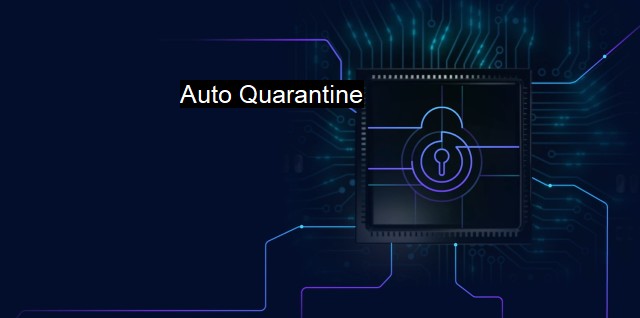What is Auto Quarantine?
Securing Networks with Auto Quarantine: A Crucial Cybersecurity Approach for Antivirus Software
Auto-Quarantine is a crucial feature in the realm of cybersecurity and antivirus software. It forms a distinct and robust defense line against cybersecurity threats, namely virus, malware, and other potentially malicious programs. An auto-quarantine function is designed to automatically allot an isolated and safe area on a device, especially when it detects any suspicious or possibly virus-infected file. From the perspective of cybersecurity, this feature significantly boosts the safety aspect and health of a device's system.Before diving deep into the nitty-gritty of auto-quarantine, it is critical to understand its fundamental principle. Auto-quarantine does what its title suggests - it automatically isolates (quarantines) any software, file, or program which appears suspicious or harmful. Similar to the principle of a medical quarantine, where people exposed to an illness are isolated to prevent further spread of the disease, auto-quarantine isolates potential and identified threats to prevent the spread of infections within the system.
Following detection, an antivirus with auto-quarantine features automatically places the identified threat in a dedicated quarantine zone. The concept of strategically relocating suspicious files into a confined space resultantly converts this hazardous file to an inactive state, keeping them away from the system files. It not only prevents the infected files from copying, deleting or tampering with the existing system's files and folders but further impedes communication with various other applications present on the device, providing a blanket of protection against possible viral assaults.
An often underestimated aspect of auto-quarantine is containment. Validating a file as malicious can sometimes take time, which is a luxury not always available in the realm of cybersecurity. Auto-quarantine, serves as an intermediate action, providing room for containment and inspection without the incessant pressure of time ticking away.
Interestingly, the auto-quarantine feature does not autonomously delete any infected files. Although, one might argue that deleting the file is the apparent solution, it is not always plausible. Deletion can cause irrecoverable damage, particularly if the suspicious files turn out to be a false positive or an essential system file. Hence, triggering a quarantine action over outright deletion is a safer bet.
Similarly, from a user-experience perspective, auto-quarantine's importance cannot be downplayed. The sudden loss of critical files might cause confusion or panic among users. mutations and alterations in viruses and malware are frequent, leading to instances wherein the antivirus program lacks the required signatures to identify the threat. Here, auto-quarantine functions undercover provide an additional safety layer.
To summarize, the relentless efforts in the cybersecurity space have embraced auto-quarantine as an operative technique to reinforce security. Solving twin-issues at once, namely maintaining the security and integrity of the whole system during threat-detection and investigation, the technique stands out effectively. Auto-quarantine equips users with immediate enforcement of a barrier around suspect files, providing a degree of comfort and convenience. Its emphasis on safeguarding key files simultaneously exhibits the efforts to keep the affected system operative. Such an arrangement is inevitably critical for both domestic users and large-scale business enterprises.

Auto Quarantine FAQs
What is auto quarantine in cybersecurity?
Auto quarantine is a feature in antivirus software that automatically isolates and contain files that are suspected to contain malware or viruses. It prevents the spread of the infection to other parts of the system, allowing for effective remediation.How does auto quarantine work?
Auto quarantine works by flagging suspicious files based on pre-defined criteria, such as file signatures or behavioral patterns. Once flagged, the file is placed in a secure quarantine area where it cannot execute or interact with other files in the system. The quarantine is then monitored for further analysis or deletion of the flagged files.What are the benefits of using auto quarantine?
The primary benefit of using auto quarantine is that it helps to contain malware or viruses, thus reducing the risk of infection spreading to other parts of the system. It also allows for more effective remediation procedures, such as deleting or repairing the infected files. Additionally, auto quarantine helps to reduce the workload on IT personnel, who would otherwise have to manually identify and isolate each suspicious file.Are there any potential drawbacks to using auto quarantine?
One potential drawback of using auto quarantine is that it can sometimes flag legitimate files as suspicious, causing them to be isolated unnecessarily. This can cause delays in workflow and increase the workload of IT personnel who must review and release these files. Additionally, some malware may be designed to evade detection by antivirus software, making the auto quarantine less effective in these cases.| | A | | | B | | | C | | | D | | | E | | | F | | | G | | | H | | | I | | | J | | | K | | | L | | | M | |
| | N | | | O | | | P | | | Q | | | R | | | S | | | T | | | U | | | V | | | W | | | X | | | Y | | | Z | |
| | 1 | | | 2 | | | 3 | | | 4 | | | 7 | | | 8 | | |||||||